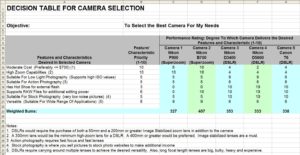How To Make Better Decisions Using a Decision Table

“One of the most important things that I have learned in my 57 years is that life is all about choices. On every journey you take, you face choices. At every fork in the road, you make a choice. And it is those decisions that shape our lives.” _Mike DeWine
Let’s face it. Decisions are important. And decisions are tough.
When we boil it all down, the quality, trajectory, and destination of our lives are largely the result of the decisions we make. As noted in the quote above, decisions shape our lives.
Think about all of the big life decisions each one of us has to make and the impact they have on our lives. Decisions such as:
● What vocation to pursue?
● Whether or not to go to college?
● If college, then which one?
● If college, then which major?
● If college, then do I continue to an advanced degree?
● If not college, then what?
● Which job to take?
● Which company to work for?
● Should I look for a new job?
● Should I accept that job offer?
● Should I start my own business?
●Should I change careers?
● When and if to get married?
● What person to marry?
● Whether or not to have children?
● If children, then how many?
● What to do if marital problems occur: Counseling? Separation? Divorce?
Change any one of your life decisions, and your life will be completely different. Not necessarily better or worse, but different.
But make a poor decision on any life decision and your life will most likely be worse off for it.
In addition to life decisions like those above, there are many lesser, but important decisions we have to make every day that impact the quality of our lives. Decisions like:
● Should I buy a house or rent?
● If a house, which one?
● What neighborhood should I live in?
● Should I move to a new house or a new neighborhood?
● Should I buy a new car?
● Which car to buy?
● Which large ticket item to buy (TV, appliance, smart phone, etc.)?
The bottom line is that if you want the best life possible, then you must make the best decisions possible. And using a Decision Table is the best way to make great and wise decisions.
The Basic Decision Making Process Using Decision Tables:
The first step in making a decision using a Decision Table is to identify and rate in priority (importance) the features and characteristics that you want from the decision you are considering. This step is crucial so take your time with it.
If you don’t know exactly what you want, then you can’t make the best decision possible. And if you don’t think it through, you are liable to miss some things that you will wish you had considered later on. The last thing you want is buyer’s remorse or to have to live with regret for a bad decision.
As an example, here are some features and characteristics you would want to consider when deciding whether or not to move to a new neighborhood.
● The quality of the schools (very important if you have children and on the resale value of your home)
● The average home cost
● The crime rate
● Is there a neighborhood watch group?
● Activities available (parks, playgrounds, lakes, clubhouses, etc.)
● Distance from your work
● Proximity to shopping
● Local Taxes
● Are the homes well maintained?
● Are there property restrictions and covenants?
● Are there children in the neighborhood? (important if you have children)
● Distance from your family
● Amount of traffic and congestion
● Are the roads well maintained?
● Is there public water and sewer?
● Resale value of other homes in the neighborhood
● Do the people seem friendly?
● Is there a fire department nearby?
● Is the neighborhood in a flood plain?
As you can see, there are many things to consider when moving to a new neighborhood. And the above list doesn’t even take into account the features and characteristics of the new house or apartment you will be moving into. Unfortunately, many people get so excited by a house they see that they forget all about the neighborhood. Big mistake! Think things through and be thorough. Know exactly what you want and need.
The second step in the decision making process is to gather information. Learn the options that are available, the pros and cons of each option, and how each option matches up with your list of desired features and characteristics. A good decision is always an informed decision.
The third step is to put all the information together in a Decision Table. This will provide a quantitative measure of each option. The option with the highest value then represents the best decision, based on what’s important to you.
One purpose of using a Decision Table is to take the emotion out of decision making and to make the process more objective.
Let’s face it, big decisions have big consequences and it is hard not to get emotional about them. The more emotional we get, however, the greater the risk of making a bad decision. A Decision Table helps remove emotion by making the decision making process less subjective and more quantitative.
Another purpose of using a Decision Table is to be able to distinguish between needs and wants.
In reality, some features/characteristics are essential (your needs) while others would be nice to have but are not really necessary (your wants). When making your decision, you must give your needs greater weight or you are liable to let your wants dominate, leading to a bad and unwise decision. We often have much greater emotional attachment to our wants, which can blind our objectivity. A Decision Table prevents this from happening.
A Decision Table Example:
A Decision Table can be done by hand or implemented in a spreadsheet program like Microsoft Excel or OpenOffice Calc.
Below is a Decision Table done in Excel that I created to decide which camera I should buy, based on the features and characteristics that are important to me. This is a real-world example of a decision I went through recently.
Camera are expensive and certain features, like zoom, were important to me because my primary application for the camera was wildlife photography. I could only afford one camera, so I wanted to make sure any camera I bought would be suitable for that primary application but would also be good for travel, family photos, etc. Thus, it had to be versatile, but if it didn’t have the capabilities needed for wildlife photography, it was useless to me.
DSLRs are the cameras of choice for professionals and photography enthusiasts. But they require expensive telephoto lenses to get the wildlife pictures I wanted and you need to toke around multiple lenses to achieve the versatility I wanted. Perhaps a superzoom camera would be better for my needs where I could get zoom far beyond that achievable with a DSLR fitted with lenses I could afford and where one lens would meet all of my needs. I needed answers to these questions so that I didn’t make a mistake and buy the wrong camera. Thus, I used a Decision Table to make my selection.
Here is the Decision Table I generated.

The table is broken-down as follows:
The first column (Column A) lists all the features and characteristics that I was looking for in a camera.
The second column (Column B) rates the priority (importance) of each of those features and characteristics to me on a scale of 1 to 10.
The next five columns (Columns C-G) show how the five cameras I was considering matched up with my desired features/characteristics based on a scale of 1 to 10. These values thus gave the camera’s performance rating for each feature/characteristic.
The “Weighted Sums” values at the bottom of the table give a quantitative value of the overall suitability of each camera to the features and characteristics that were important to me. This value is determined by summing the product of the priority rating and the performance rating over all of the features/characteristics for each camera. For example, the Excel formula used to calculate the Weighted Sum for the Nikon P900 Superzoom Camera in Column (C) would be:
=SUM($B$14*C14 + $B$15*C15 + $B$16*C16 + $B$17*C17 + $B$18*C18 + $B$19*C19 + $B$20*C20 + $B$21*C21)
In the above example, the Nikon B700 Superzoom Camera gave the highest Weighted Sum value, indicating that it was the one that best met my needs. And it was the one I actually bought.
The Decision Table made it easy for me to pick the best camera for my needs and prevented my emotional bias towards DSLRs from misleading me into a wrong decision. The 60x zoom of the B700 allows me to get pictures I could never dream of getting with a DSLR. This was definitely the right camera for me but, if I hadn’t used a Decision Table, I probably would have purchased a DSLR and regretted it.
Action Plan:
Here is your Cerebral Advantage Action Plan for making informed decisions using a Decision Table.
Step 1: Make a list of all of the features and characteristics you are looking for in the thing you are deciding upon. List everything you can think of. Include your wants as well as your needs. Take your time with this and be thorough. If possible, brainstorm this with your spouse or a friend. Two heads are often better than one for this task.
Step 2: Rate each feature/characteristic in priority (importance) to you, using a scale of 1-10. Review your ratings several times and adjust as needed until you are certain the ratings are consistent with your needs, wants, and values.
Step 3: Research the options available and select the best ones for you to consider. Again, be thorough so that no viable option is overlooked. The Internet is generally the best place to start your research and may be all you need. However, other sources may be useful and could include libraries, friends, relatives, teachers, coaches, and local experts who have knowledge in the options you are evaluating.
Step 4: Set up your Decision Table as shown in the example above. Rate the performance of each option for each feature/characteristic using a value of 1-10. Calculate the Weighted Sums for each option by summing the products of the performance rating and the priority value for each feature/characteristic.
Step 5: Select the option that has the highest Weighted Sum value. If two or more options have very similar values, select the one that has the highest value based only on your highest priority features/characteristics.
Step 6: Take action and implement your decision. No decision is complete until it is acted upon.
Summing Up:
Making sound and wise decisions is a crucial part of a life well lived. But, there is a right way and a wrong way to make decisions.
Most people make decisions by listing the pros and cons of each option and then choosing the one with more pros than cons. This approach, however, is deficient because it gives equal weight to each feature/characteristic, thereby giving your wants equal weight with your needs. This is the wrong way to make wise decisions.
By rating each feature/characteristic by priority (importance), you are able to distinguish between needs and wants, thereby preventing you from making a bad decision based on over-weighted wants. This is the power of using a Decision Table.
And, this is how wise decisions are made.
Decision Tables may seem intimidating at first, but they aren’t really. They are actually easy to implement once you’ve done it once or twice.
The best approach is to set up a template in Excel, OpenOffice Calc or other spreadsheet program. Then, once you have your research done, all you have to do is enter the data into the template, do the ratings, and you have your objective decision made. Doing the research is the hard part. Entering the data and doing the analysis in the spreadsheet will only take a few minutes. And you can save the final spreadsheet to document how your decision was made.
While it is not necessary to use a formal Decision Table when making minor decisions, such as what cereal to buy, the same mental process should be used for every decision you make:
● What are the features/characteristics I need and want (in a cereal)?
● Which features/characteristics are most important to me?
● What are the options (cereals) available?
● Which option (cereal) best matches up with my prioritized list of features and characteristics?
Get in the habit of thinking like this when making the small decisions and you’ll be well prepared when it comes time to make a big decision.
Think right. Live well.
NOTE: THIS ARTICLE MAY CONTAIN AFFILIATE LINKS. PLEASE SEE OUR AFFILIATE DISCLAIMER FOR MORE INFORMATION

Other Articles You Might Like:
● The Secret to Making Bold Improvements in Your Life
● The Power of Precise Thinking
● Your Mind Is Like a Garden. Tend It Well.
● 25 Characteristics of Successful People
● How to Use Questions to Supercharge Your Critical Thinking
● David Kekich’s 100 Credos: A Formula For Successful Living
● 45 Virtues For Living a More Joyous, Fulfilling and Successful Life
● How To Write a Personal Mission Statement That Brings Clarity and Purpose To Your Life
● How Building a Personal Advisory Team Can Help You Succeed In Every Area Of Your Life





No Comments